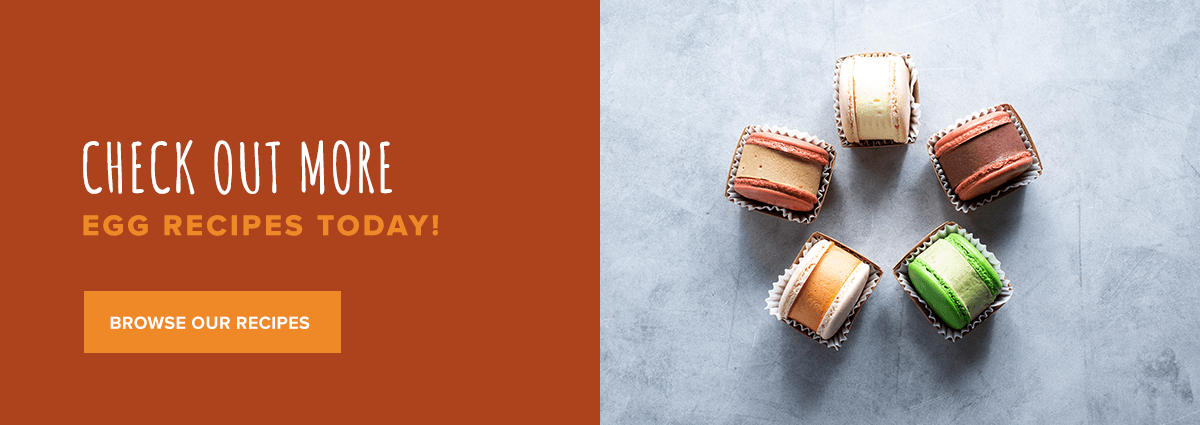How to Make Macarons
Posted on: March 21st 2023

Of all French pastries, macarons are one of the most iconic. Colorful, delicate, and delicious, these delightful little cookies are just as popular in French patisseries as in American bakeries. You can find these airy cookies in a range of flavors, from classic chocolate and pistachio to red velvet and mango. Macarons are also known for being a bit tricky to make, thanks to the meringue-based macaron shells. Yet the results are definitely worth the effort.
Knowing a few tips and tricks for making these cookies can help any beginner baker master the macaron. Discover how to make French macarons for your next baking endeavor.
What Are Macarons?
Macarons are a type of confectionary composed of two cookie shells around a filling traditionally made from ganache or buttercream. Don’t confuse macarons with macaroons — while both cookies contain egg whites, macaroons contain shredded coconut and may be dipped in chocolate. In contrast, macarons use whipped egg whites, almond meal, flavored fillings, and come in a rainbow of colors and flavors.
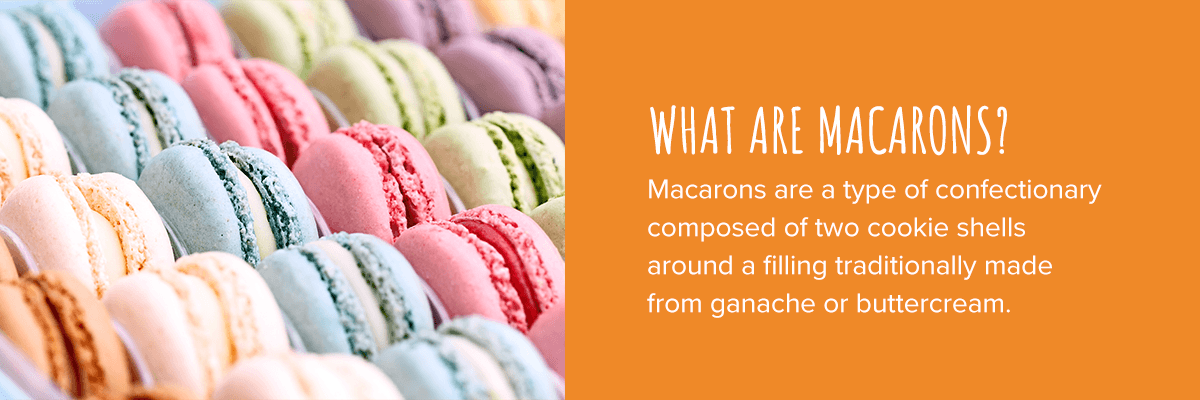
The individual cookies that make up a macaron are known as macaron shells. Their meringue base gives the shells a crisp surface that cracks into chewiness as you take a bite. The texture and lift of macarons come entirely from beating the egg whites, as these cookies use no leavening agents.
The History of Macarons
Before they were on lists of must-have foods to try while visiting Paris, macarons were beloved by royalty as well as everyday people. Although macarons are now most associated with France, people commonly believe these elegant confectionaries originated in Italy. Venetian monasteries baked the cookies as early as the late 1400s. Catherine de Medici introduced the sweet to France in the 16th century through her Italian chef.
The macaron that first arrived was just a chewy cookie, like today’s macaron shell without the filling. This version caught on when two nuns in Nancy, France, baked the cookies to support themselves after their abbey was closed. Several variations have now evolved, including the classic macaron that’s popular today.
The double-cookie version was developed in Paris in the 1830s and popularized by the Ladurée pastry house, which is still open in Paris. Regions throughout France have also developed their own varieties. Now, March 20 is Macaron Day, celebrated in Paris with free samples of macarons from local pastry houses.
Different Types of Macarons
Macarons have gone through many changes since the 16th century. These Instagrammable cookies now come in bright or pastel colors and a dizzying range of flavors. Classic macarons are sweet and light, but some shops have also experimented with savory combinations. Macaron fillings can include ganache, buttercream, fruit jam, marzipan, or even a disk of ice cream. You can flavor the sweets with fruits, spices, coffee, flowers, or liqueurs.
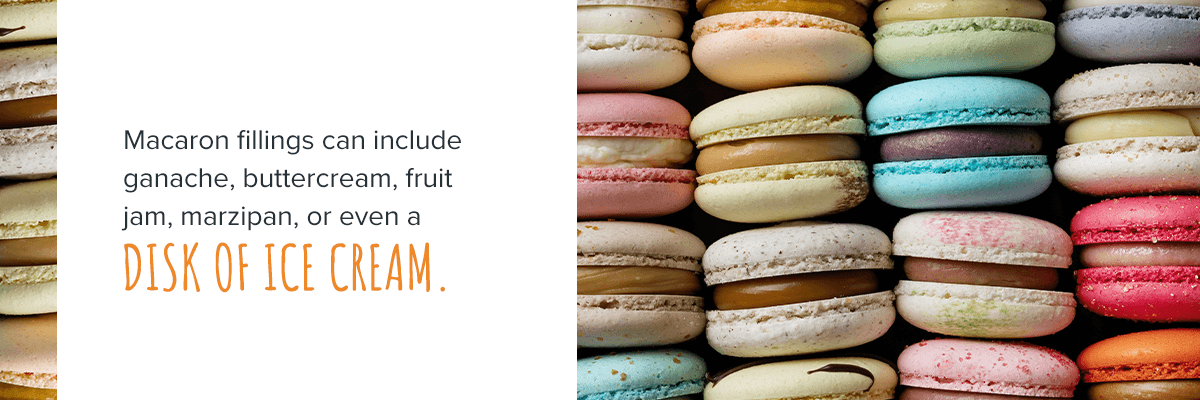
Here are a few of the most popular macaron flavors you may want to try, plus a few inventive combinations for the adventurous:
- Chocolate: Chocolate macarons contain cocoa powder and chocolate ganache.
- Vanilla: With a light vanilla bean flavor, these pastries have a buttercream center.
- Pistachio: Pistachio macarons are flavored with pistachios and white chocolate ganache.
- Coffee: Coffee macaron shells pair perfectly with coffee buttercream.
- Hazelnut: Hazelnut macarons contain hazelnut cream filling.
- Rose: These sweets have rose petal buttercream.
- Blackcurrant: Blackcurrant jam filling is the star of these sweets.
- Lemon: Tart lemon zest elevates this macaron.
- Raspberry: Pink raspberry macaron shells go well with chocolate buttercream.
- Earl grey: Cream filling infused with earl grey tea is light and airy.
- Salted caramel: The sweet and salty caramel filling is an indulgent treat.
What You Need to Make Macarons
You’ll need to gather several items and ingredients you may not usually have on hand before making macarons. You might have to make a special trip to a store that sells the equipment you need.
You can find several methods for making macarons, including the French, Italian, and Swiss methods. Our recipe for simple vanilla macarons uses the French method, which many consider the easiest. To make specialty macarons, you must incorporate different flavors into your macaron batter or filling — but remember that any flavor additions may alter the batter’s texture and impact the final product after baking.
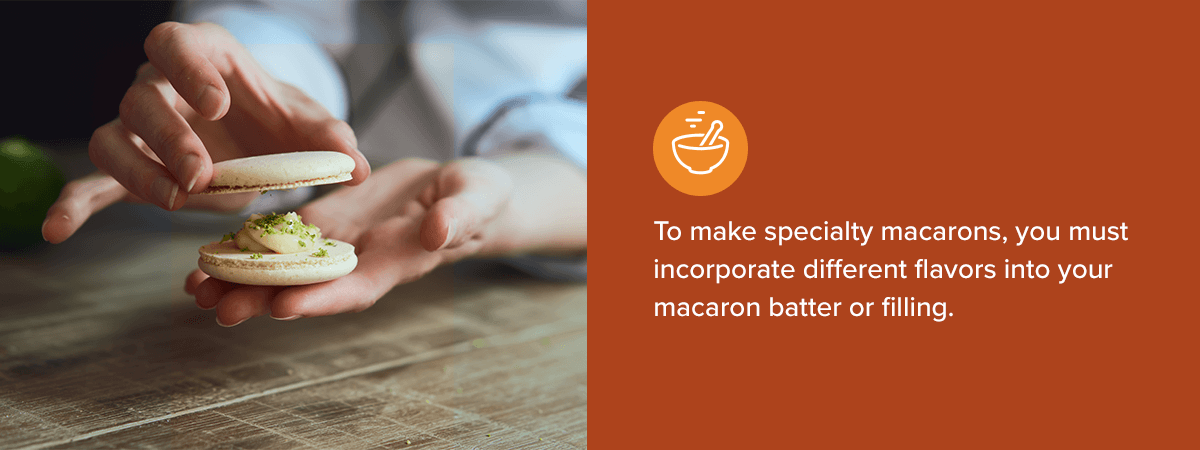
Here’s everything you need to make macarons at home:
Ingredients
Macaron shells only require a handful of simple ingredients to make:
- Egg whites: The primary ingredient in macaron batter is egg whites beaten to make a meringue. For the best results, it’s essential to use fresh egg whites rather than liquid egg whites from a carton. Knowing what factors to consider when buying eggs can help you find the best eggs for your macarons. Egg whites begin thinning as the egg ages, so ensure your eggs are fresh to get the best results.
- Superfine almond flour: The only flour that works for macarons is almond flour. This flour is widely available in most grocery stores, so you likely won’t have trouble finding it. If you can’t find superfine almond flour, don’t worry — you’ll be running the flour through a food processor and sieve anyway.
- Superfine sugar: Sugar keeps the proteins in the egg whites from collapsing and gives macarons their sweetness. Superfine sugar is ground finer than granulated but not as fine as confectioner’s sugar. If you can’t find superfine sugar, you can make your own by pulsing granulated sugar in a food processor for a few seconds.
- Confectioner’s sugar: You’ll also use confectioner’s sugar in your macarons, as this sugar thickens the batter and provides additional sweetness.
- Cream of tartar: Cream of tartar prevents the egg whites from collapsing by helping them hold onto more air, making a sturdier meringue.
- Salt: A pinch of salt helps stabilize the meringue even further.
- Vanilla extract: If you want your macarons to taste more like vanilla and less like almond, add vanilla extract to the batter.
- Gel food coloring: Coloring your macarons is optional but can make the cookies even prettier. If you want to use food coloring, get gel food coloring instead of liquid.
Kitchen Equipment
You’ll also need the right kitchen equipment to make your macarons:
- Electric mixer: An electric mixer is critical for making the meringue. Standing or handheld mixers work equally well.
- Glass or metal bowls: Plastic bowls tend to hold onto food residue, which can impact your meringue. Opt for glass or metal bowls.
- Food scale: This macaron recipe uses grams, so you’ll need a food scale to find exact measurements.
- Fine mesh sieve: A fine mesh sieve ensures your almond flour and confectioner’s sugar are finely sifted.
- Rubber spatula: A rubber spatula works best for gently folding the macaron batter.
- Piping bag and tip: A piping bag and round tip are for piping the batter and filling.
- Baking sheet and liner: You need a baking sheet and parchment paper to bake your macarons. You can also find silicone macaron baking mats with circle outlines so you know how much filling to pipe for uniform macaron shells.
- Cooling rack: A cooling rack helps your macaron shells cool faster.
- Food processor: A food processor ensures the flour and sugar are very fine.
- Egg separator: Although not necessary if you know how to crack an egg, an egg separator makes it easy to keep your yolks and whites completely separate.
How to Make Macarons
Macarons can be intimidating to home bakers. The ideal macaron has a smooth, even surface, chewy texture, and round shape. Both cookies should be equal in size and have “feet” around the bottom to prevent the filling from falling out. These cookies certainly require precision to turn out perfectly. However, an easy recipe and a little patience go a long way in putting even the most inexperienced baker on the right track. Just remember that practice makes perfect!
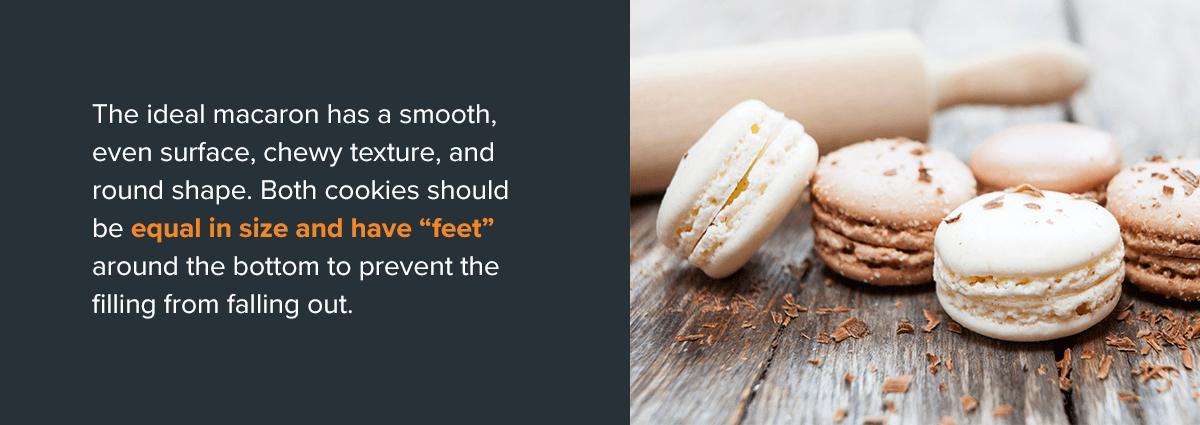
Here are the steps for how to make easy macarons:
1. Complete Your Prep Work
Before you begin making the macaron shells, complete any prep work that’s needed. Age 100 grams of egg whites — between three and four eggs — the day before making your macarons. To age egg whites, allow them to sit covered in a clean bowl in your refrigerator for 24 hours before using them. Then line three baking sheets with silicone macaron baking mats or use parchment paper with the ends glued down with small dabs of butter.
2. Sift and Process Flour and Sugar
Sift 80 grams of confectioner’s sugar, 125 grams of almond flour, and ½ teaspoon of salt with the mesh sieve into a large bowl. Press any larger pieces through the sieve with a spoon. Then pulse the flour and sugar on low speed in a food processor for several seconds. Sieve the ingredients again. Set this mixture aside.
3. Make the Meringue
Bring your aged egg whites to room temperature before adding them to a separate bowl or your stand mixture. Add ¼ teaspoon of cream of tartar, ½ teaspoon of salt, and ½ teaspoon of vanilla extract to the egg whites.
Beat the mixture on medium speed until soft peaks form. Use the rubber spatula to gently fold one to two drops of gel food coloring into the meringue. Add about ⅓ of the 80 grams of superfine sugar to the mixture and continue beating on medium-high speed for five seconds. Add another ⅓ of the sugar while the mixer runs. Beat for five more seconds, then add the remaining sugar. Continue beating on medium-high speed until you see stiff, glossy peaks form.
4. Mix the Batter
Slowly fold ⅓ of the dry ingredients into the bowl with the wet ingredients. Fold until the mixtures are combined before adding another ⅓ of the flour and sugar. Continue until the ingredients are combined, and the batter has the consistency of honey. Slowness is crucial here, as you don’t want to overmix the batter.
5. Pipe, Dry, and Bake the Macarons
Fit a medium round piping tip on your piping bag and fill the bag with the batter. Hold the piping bag at a perpendicular angle over the baking sheets and pipe 1 ½- to 2-inch rounds. The macarons should be about 1 to 2 inches apart. Tap the baking sheets on the counter to release any air bubbles. Preheat the oven to 325 degrees Fahrenheit.
Allow the macaron shells to sit on the counter until they feel dry to the touch, for about 30 to 60 minutes. This step is vital, as it allows the macarons to form a smooth skin and helps create the characteristic “feet” on the bottom of the cookie. Bake the macarons for 13 minutes in your preheated oven.
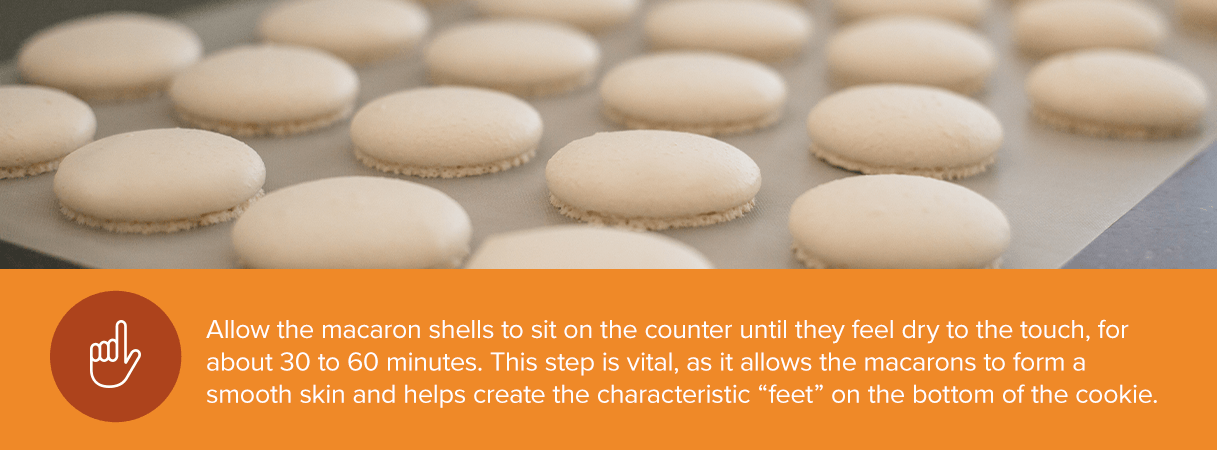
6. Make the Macaron Filling
As the macarons bake, make your filling. This recipe is for a simple French buttercream. Here is how to make macaron filling:
- Combine ½ cup of granulated sugar and 3 tablespoons of water in a saucepan on the stove over low heat until the sugar dissolves.
- Increase the heat to medium-high and bring the mixture to a boil.
- Beat five egg yolks with a mixer until foamy and thick.
- Heat the sugar and water mixture to 240 degrees Fahrenheit and remove from heat.
- Slowly drizzle the water mixture into the egg yolks while the mixer runs.
- Mix until the mixture is at room temperature.
- Add 1 cup of softened, unsalted butter one cube at a time, incorporating each piece.
- Mix in one pinch of salt and 1 teaspoon of vanilla until the buttercream is creamy.
7. Assemble the Macarons
The macarons are finished baking when they form feet. Test one by lightly tapping it with a spoon. If the cookie is wobbly, it needs a couple more minutes in the oven.
Allow the macaron shells to cool on the baking sheets for 15 minutes and then on cooling racks while you fill a piping bag with buttercream. Pipe the filling onto the flat side of one shell and form a sandwich with another shell.
Tips for Making Macarons
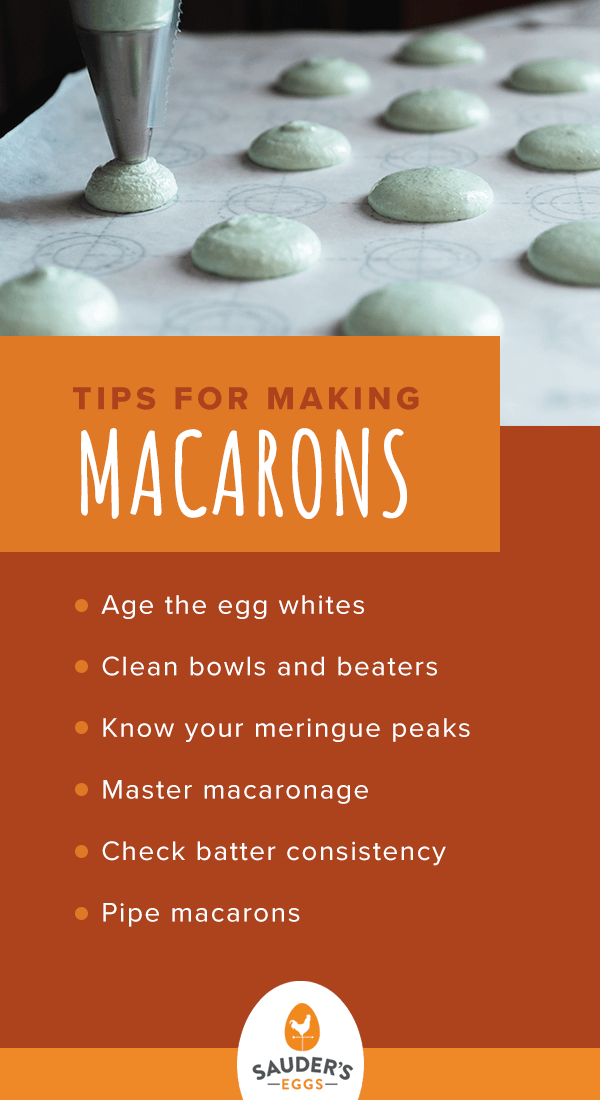
When you know the basics of how to make macarons, having a few tricks up your sleeve can make the process go that much simpler. Consider these tips for making macarons:
- Age the egg whites: Most macaron bakers agree that it’s helpful to age your egg whites before using them. This process may help improve the whites’ elasticity, making it easier to whip them into stiff peaks for the meringue.
- Clean bowls and beaters: Wipe your bowls and whisk attachment or beaters with vinegar or lemon juice to eliminate grease.
- Know your meringue peaks: Ensuring you have the right peaks is critical when making meringue. Not mixing stiff peaks can result in hollow macaron shells. Stiff peaks are glossy and smooth with sharp points. You will see these peaks forming in the bowl or clinging to the whisk attachment or beaters once you lift them from the mixture. If you flip the bowl upside down, stiff peaks will not move or run out.
- Master macaronage: Macaronage refers to the process of creating macaron batter with the perfect flowy consistency. Fold the batter slowly until you achieve the right consistency. You may need to do 40 to 60 folds before you reach this point.
- Check batter consistency: To determine when the batter is ready to bake, allow the batter to drop off your spatula in a figure 8. The 8 should fold back into the batter in around 10 seconds. If it does so faster, you’ve likely overmixed the macarons. Any longer and you need to mix more.
- Pipe macarons: For beautifully piped macarons, your batter should be thick enough to pipe but thin enough for the peaks of each macaron shell to fall on themselves. Pipe the batter at a 90-degree angle to make perfect circles.
How to Serve Macarons
There are nearly as many ways to serve macarons as there are ways to eat them. However you serve these sweets, they should be at room temperature. If you’ve been refrigerating your macarons, let them sit at room temperature for at least 20 minutes before serving.
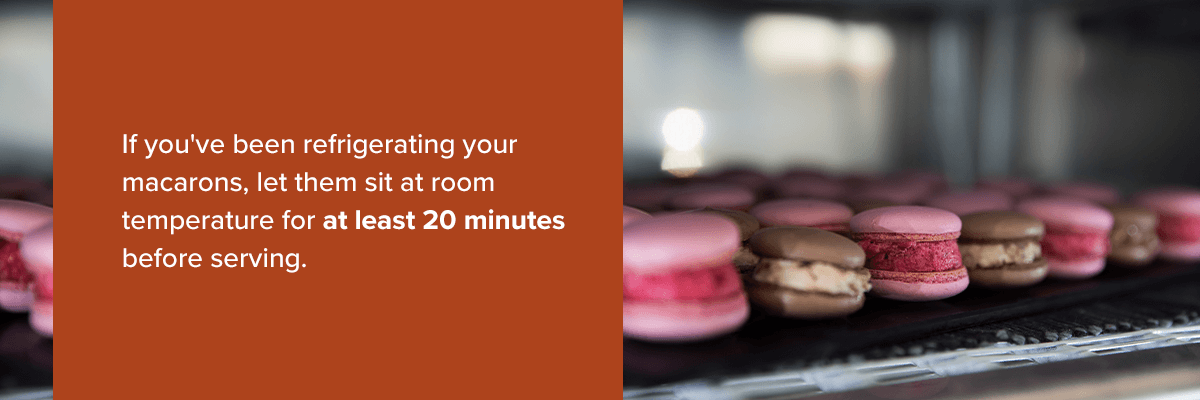
Here are some of the best ways to serve macarons:
- With afternoon tea: A cup of hot tea in the afternoon pairs great with macarons. Brew your favorite cup of tea and enjoy a couple of macarons while you sip.
- In a tower: Stacked macarons make a lovely display for a party, corporate event, or wedding. Arrange macarons by flavor on a cupcake tree stand or layer them vertically in a tiered stand with a lip around each row, so the macarons stay in place. You can also wrap a foam cone in tissue paper and stick the macarons into the cone using toothpicks.
- As a gift: Macarons make great housewarming gifts and wedding and shower favors. Place two macarons in a small plastic box and tie them with a ribbon.
- With champagne: Champagne is the perfect accompaniment to these elegant pastries. Serve chilled champagne alongside fruity macarons for a bridal shower, anniversary party, or New Year’s Eve celebration.
- With café gourmand: Most dessert shops in Paris offer a café gourmand option, which is coffee served with a selection of the day’s desserts. Serve up a small plate of macarons with an espresso for a nod to this Parisian tradition.
- With ice cream: If using a disc of ice cream as your macaron filling isn’t enough, try serving the pastries on top of ice cream. Top a scoop of ice cream or gelato with one or two macarons for an extra-decadent treat.
How Long Do Macarons Last?
Macarons will last for several weeks if stored correctly. In fact, fresh macarons taste best after being stored in an airtight container in the refrigerator for at least 24 hours. This resting period allows the flavors to open and the macarons shells to absorb some of the filling’s moisture.
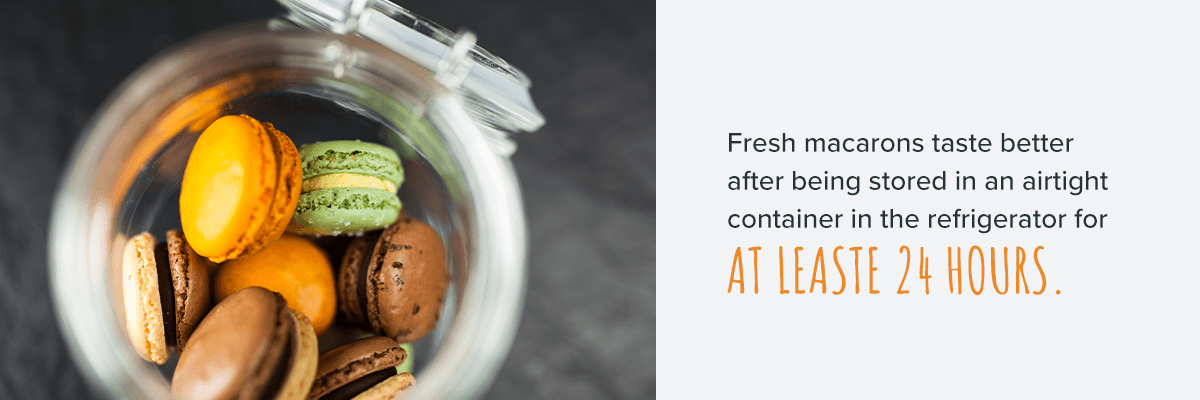
If you want to keep your macarons for longer, be careful to preserve their delicate texture. Store macarons in an airtight container for up to seven days at room temperature. The sweets will last up to seven weeks in the refrigerator. Freezing macarons can affect their texture, so it isn’t recommended.
Check Out More Egg Recipes Today!
While it may take some practice and patience, making macarons is extremely rewarding. As you become better at baking these delicate pastries, you can have fun with new flavor and filling combinations. Sharing your creations with friends and family makes them even sweeter!
When you buy ingredients to make your macarons, choose eggs from Sauder’s Eggs. As a family-owned business, we work closely with our suppliers to ensure our high-quality, farm-fresh eggs provide great taste in all your homemade recipes. Find Sauder’s Eggs near you with our store locator. For more tips and tricks for using eggs, check out our blog posts or browse our recipes for more inspiration!

